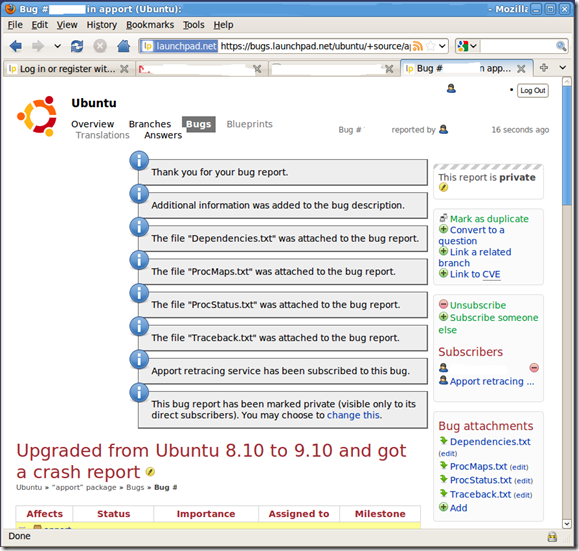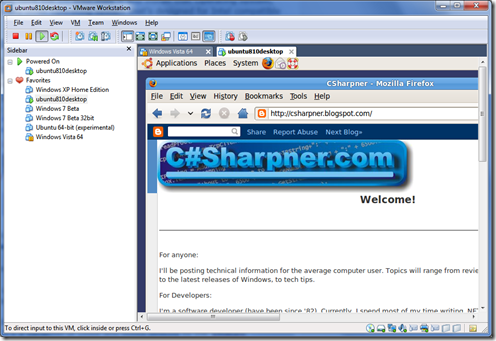See part 1 here:
Ubuntu Linux: Upgrade to 9.10 Karmic Koala Experience (Part 1)
After the upgrade finished, it rebooted. Here’s my new login screen:
As you can see, it needs some work (things are overlapping in the bottom right). It does look nice though and it now shows me the user account (or accounts?) that I can choose from, whereas before, I had to “know” the name of the user accounts. In normal use, this isn’t a problem, but in a VM that I may not touch for months, I can easily forget the login name, especially in a VM that I didn’t build and didn’t create the name of the account.
I’ll have to figure out how to change the machine name eventually, as “ubuntu810desktop” is no longer an appropriate name, of course.
After I rebooted and logged in, there was a crash report icon in the upper right. I clicked it and it asked for my password:
then this:
I was not aware of a crash. I looked up “hap_lpadmin”. This seems to be related to Python. I do have Python 2.5 and 2.6 installed in this virtual appliance. I clicked “Report Problem…”, then it went away, then another crash icon in the upper right and another PW prompt.
Oh! Not looking good!
Interesting… I was not prompted for permission to install these and I don’t know what they are.
To continue with what? I went ahead and registered and let the bug report complete and entered what little I know. I also noticed, while typing an explanation into their web form, that my keyboard layout got hosed. When I first downloaded this “Virtual Appliance” of Ubunuto 8.10 from the VMWare virtual appliances site, the keyboard layout was set for Afghanistan. I changed it to use my Microsoft Internet keyboard and USA. After the upgrade, it’s acting like an Afghan keyboard again (can’t type double or single quotes) but when I go to keyboard settings, it still shows my own settings. It’s not using what it’s showing.
After submitting the report…
I don’t know how important it is to keep this bug report information private, but I went ahead and erased all identifying information from this image before I posted it here.
Rebooting now, to make sure everything comes up cleanly…
Ah Ha! On the login screen, I noticed the keyboard is “USA (Alternative international (former us_intl))”. This is not what the keyboard applet showed me before I rebooted. I’ll change it now to just “USA” to see if that takes care of the problem. Looking at the prior login screen capture, it too shows an international layout, which disagrees with what the keyboard applet showed after logging in.
The login in sequence does some butchering to the screen… showing 4 squished images of what it’s attempting to show, then cropping off all but the upper left quadrant. Then it gets to the desktop OK. It happened too fast for me to get a screen shot though.
OK, back into the desktop with no crashes and the keyboard seems to be behaving properly now. Looks like the upgrade is finally complete.















